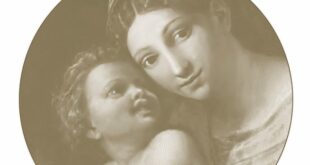The Italian-American community has reacted with dismay to the University of Notre Dame’s decision to enshroud a series of 12 murals depicting the life of Christopher Columbus.
“This is another example of revisionist history and a slap in the face to all Italian Americans,” says Italian American One Voice Coalition spokesperson André DiMino. “I implore the president of Notre Dame to reconsider his decision and not give in to the hysteria of the moment. Italian Americans celebrate Columbus’ achievement of uniting the continents.”
“This is not the first time that Christopher Columbus has been under attack,” says NIAF Vice Chair John F. Calvelli. “We cannot cover up our history. At the end of the day, we have to have an honest conversation.”
Painted by Luigi Gregori between 1882 and 1884, the murals have adorned the second floor of the Main Building on campus for more than a century. They first came under fire by Native American activists in 1995. At the time, the university published pamphlets placing the murals in historical context.
The decision to obscure the paintings came in the wake of a 2017 open letter bearing 340 signatures contending the mural celebrated slavery and depicted Native and African Americans stereotypically.
In announcing his decision, University President the Rev. John I. Jenkins indicated that the murals would be uncovered on special occasions and that high-resolution images of the mural would be made available on line.
“In recent years, many have come to see the murals as at best blind to the consequences of Columbus’s voyage for the indigenous peoples who inhabited this ‘new’ world and at worst demeaning toward them,” Jenkins wrote in an open letter of his own.
NIAF CEO Lawrence Purpuro had the following to say in response: “It is both unfair and totally unrealistic to apply today’s political norms to a historical figure from 500 years ago. If the practice of applying today’s standards to historical figures made sense, there would be a strong argument to remove memorials and monuments to Thomas Jefferson and George Washington — both of whom were supporters of the abhorrent practice of slavery.”
Opinions can be sent to president@nd.edu.
The following opinion piece was submitted by John Mancini. executive director of the Italic Institute of America in Floral Park, New York.
When art offends
The administration at Notre Dame University has announced it will cover up painted murals of Christopher Columbus. It seems the college received a petition from 300 of its students who are offended by the murals, which have been there since 1884.
Painted by Italian artist Luigi Gregori, the murals commemorate the saga of 1492 when the New World was joined to the Old by a courageous navigator from Genoa. Depicted in the murals are Taino natives of Hispaniola. To some, the natives are depicted as too servile; to others the sight of Columbus is insulting. For far too many people, he has wrongly become the personification of genocide and everything evil in Western Civilization.
I shall not use this space to refute all the calumnies against a man whose genius and grit changed mankind forever … and ultimately for the better. Instead, let’s look at the murals as art.
Art, it seems, is more sacred than anything nowadays. I know that because for many years I and other proud Italian Americans have been objecting to the relentless deluge of Mafia movies. We claim often that they are insulting, demeaning, and portray our culture as crime-ridden and violent. To every charge we make, the answer is always the same: “The Godfather” is an artistic masterpiece, “The Sopranos” is a work of art.
The supporting arguments are that these Mafia characters are three-dimensional; they are complex; they are tormented souls, such as Tony Soprano needing a shrink. College courses around the country incorporate Mafia movies into their humanities lectures. See how light and shadow dramatize extortion scenes, how “an offer he can’t refuse” has become universal lexicon, and how murdering your enemies during a Catholic baptism is cinematic genius.
On and on, we are rebuffed, belittled, and lectured on the importance of Mafia movies. Of course, the biggest shock is that those defending the “art” of Mafia movies tell us these films are not really about Italians – Italian gangsters are only the “symbols” of America’s turmoil. If this is all so, then the Columbus murals are also American works of art.
Television networks don’t delete Mafia movies from their broadcasts to respect our feelings. Hollywood hasn’t stopped churning them out every year. Why should they? As the MGM motto states “Ars Gratia Artis” (Art for Art’s Sake). We may cover up pornographic art. We may ban political art or racist art. The Notre Dame murals are none of these – they tell a true story.
In one mural, Columbus is shown in chains with the caption “Bobodilla Betrays Columbus.” This is a historical fact. Columbus was arrested for punishing Spanish colonists who exploited the natives. Other murals show half-naked natives, which they were in 1492. Another mural shows Columbus introducing Christianity to the natives, which he did.
What the murals do not depict — and this may be the real problem — is Spanish cruelty. By the same token, they do not depict native cruelty — Columbus lost 39 of his Santa Maria crew to an Indian massacre — or native cannibalism.
Notre Dame’s knee-jerk reaction to a few students is to cover the murals, as the Italian government did recently when some Iranian clerics visited Rome, so as not to offend. This is a sort of Solomonic solution to avoid destroying the murals. Notre Dame claims the fabric covers will be removed at appropriate times. When, I can’t imagine.
If the label “art” can protect offensive films, surely historic 19th-century paintings deserve the same defense.
To receive free brochures in defense of Columbus, visit www.italic.org or request them by emailing ItalicOne@italic.org
 Fra Noi Embrace Your Inner Italian
Fra Noi Embrace Your Inner Italian






